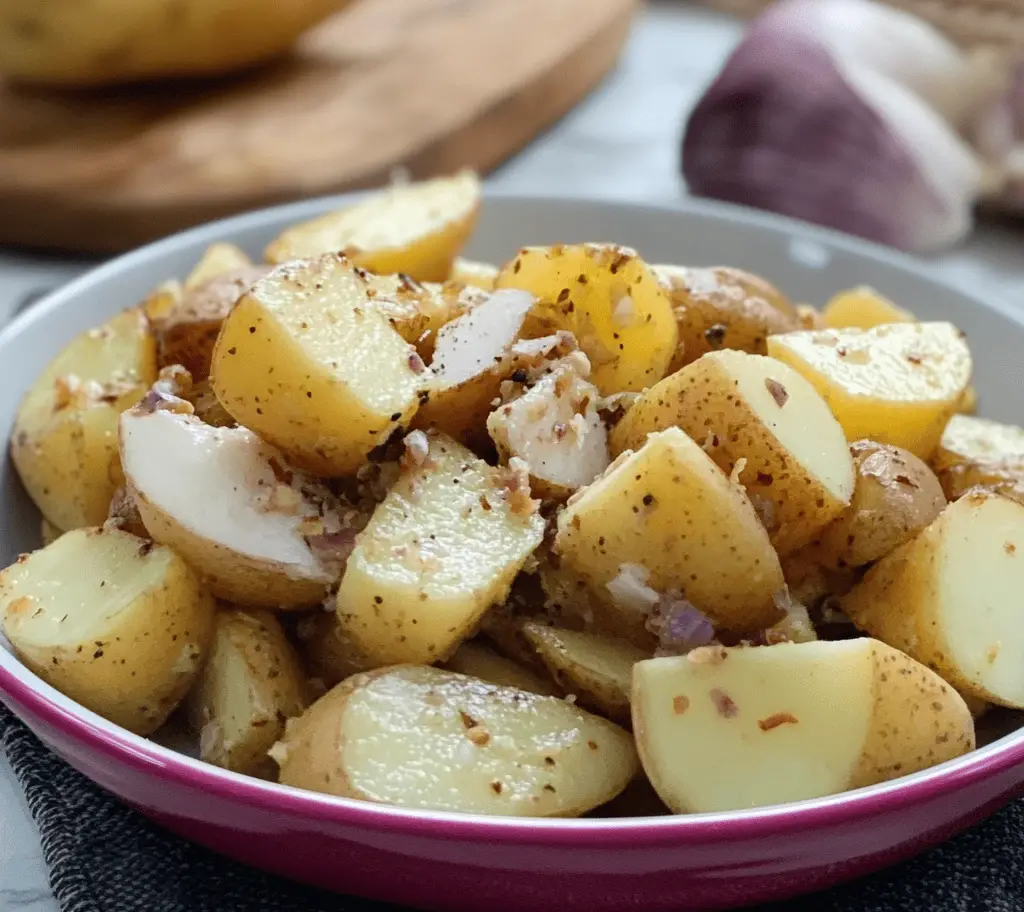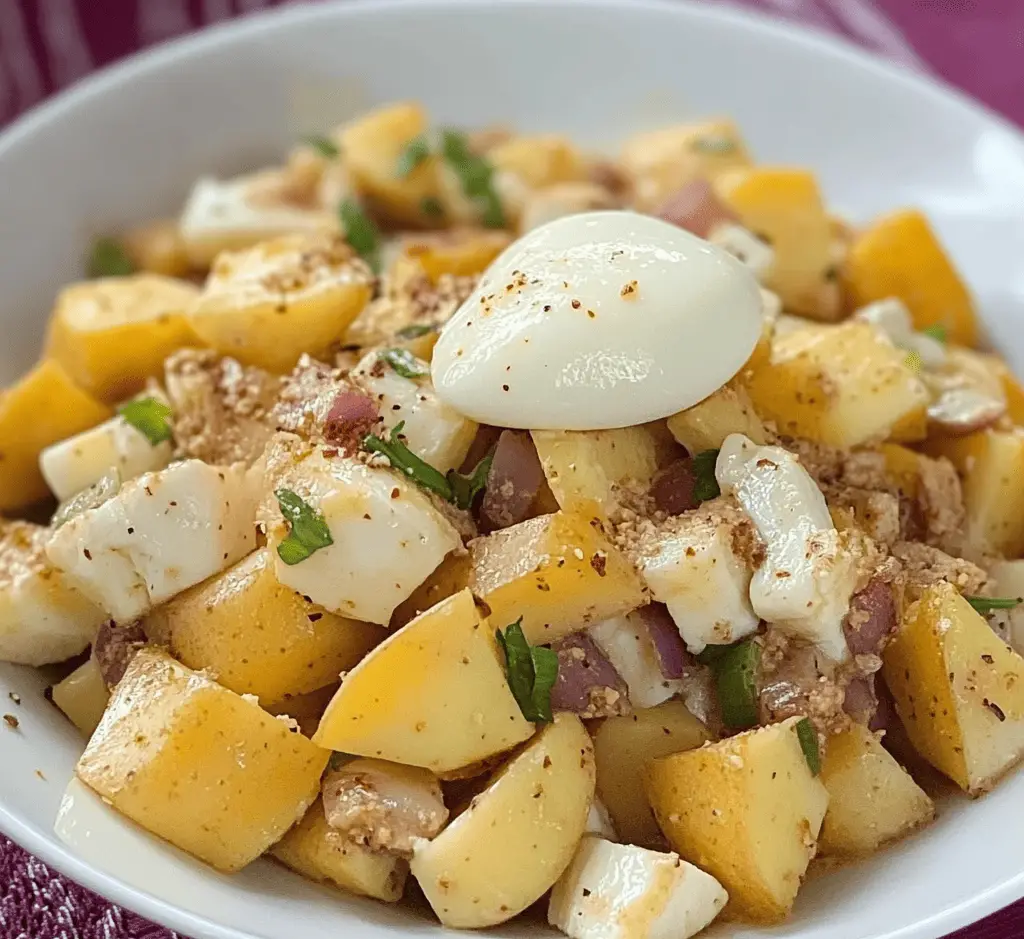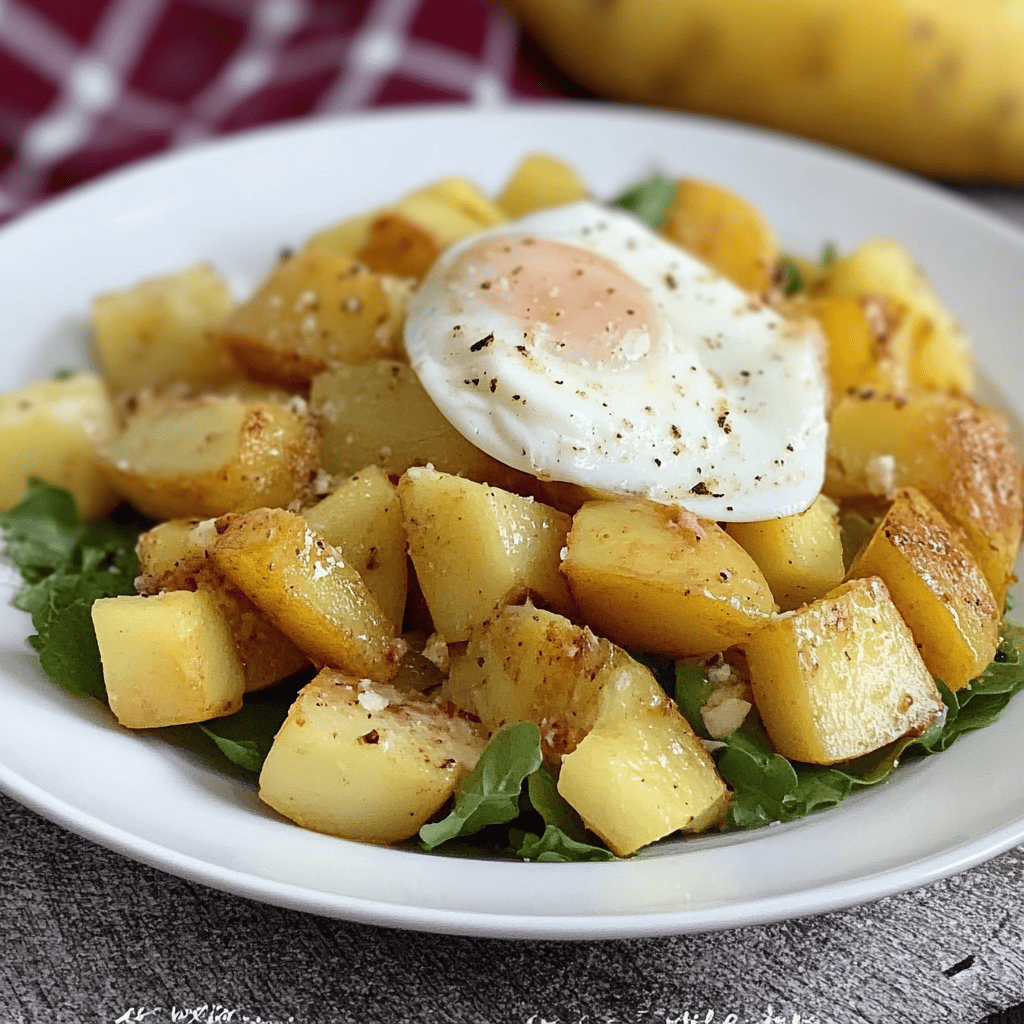Potato Salad with Egg and Tuna: A Mediterranean Classic, Nutritious and Versatile
Introduction
In the vast and delicious universe of salads, there are preparations that transcend borders and have established themselves as true culinary classics in countless cultures. Potato Salad with Egg and Tuna is undoubtedly one of them. This dish, which combines the hearty softness of boiled potatoes with the protein richness of a hard-boiled egg and the salty umami of tuna, is a testament to how simple ingredients can come together to create a deeply satisfying gastronomic experience. More than just a salad, it’s a complete meal, ideal for any time of year, but especially appreciated in the warmer months for its freshness and ability to be prepared in advance. Its versatility makes it the perfect choice for a light lunch, an uncomplicated dinner, or as a robust side dish at any family or social gathering. Get ready to discover the secrets of this timeless dish that delights palates with its balance of flavors and textures.
Detailed History: The Global Journey of the Potato and the Birth of Potato Salad
The history of potato salad is a fascinating journey intertwined with the domestication of the potato in the Andes and its subsequent global expansion. Native to the highlands of Peru and Bolivia, the potato was cultivated by pre-Columbian civilizations like the Incas more than 8,000 years ago. Following the Spanish conquest, the potato arrived in Europe in the 16th century, initially as a botanical curiosity and animal feed, but gradually, as its nutritional value and adaptability became understood, it became a vital food staple, especially in Ireland and Prussia.
The concept of “potato salad” as we know it today has its roots in Europe, particularly in Germany. The earliest versions of potato salad are believed to have emerged in Germany in the early 17th century, shortly after the potato had become established as a mass-produced food. These early salads were often simple: cooked potatoes tossed with vinegar, oil, and herbs. The acidity of the vinegar not only enhanced the flavor but also helped preserve the dish, an important consideration in times without modern refrigeration. The influences of German potato salads, characterized by their vinegar-based dressing (in contrast to the creamier American versions, which later evolved with the popularity of mayonnaise), spread throughout Europe.
More Details on the History and Fusion of Potato Salad with Egg and Tuna
The inclusion of egg and tuna in potato salad marks a significant evolution, transforming a side dish into a complete, protein-rich main dish. This addition reflects the adaptation of potato salad to the needs and tastes of diverse Mediterranean and Atlantic cuisines, where fish and eggs were fundamental components of the diet.
In the Mediterranean basin, especially in countries like Italy, Spain, and France, tuna has been a vital food source for centuries, valued for its abundance and its ability to be preserved in oil or brine. Although its name suggests Slavic origins, “Russian salad” (salade russe) is a very popular dish in Spain and Latin America, often including tuna, potatoes, peas, carrots, and mayonnaise. Although it differs from our salad, it shares the idea of using potatoes as a base for a cold, protein-rich dish.
The combination of tuna and egg with boiled potatoes became particularly popular in summer cooking and picnics, where the need for cold and nutritious dishes was paramount. Eggs, a cheap and accessible source of protein, were incorporated for their nutritional value and creamy texture when hard-cooked. Canned tuna, which became widely available in the early 20th century, offered a convenient and long-lasting protein option, ideal for preparing quick and filling meals.
Our “Potato Salad with Egg and Tuna” is distinguished by its simplicity and freshness. It is often dressed with a light vinaigrette based on olive oil, vinegar, and mustard, which enhances the natural flavors of the ingredients without the heaviness of mayonnaise. The inclusion of red onion and fresh herbs adds a touch of pungency and aroma that elevates the dish. This style of salad reflects a more direct cuisine focused on highlighting the quality of each component. It is a dish that speaks to home cooking, the tradition of making the most of available ingredients, and the pursuit of meals that are simultaneously nutritious, delicious, and refreshing. Its endurance over time and its presence on countless tables around the world are a testament to its success.

Potato Salad with Egg and Tuna: Detailed Recipe
INGREDIENTS
- 4-5 medium potatoes (approximately 600-700g), preferably varieties that retain their shape when cooked, such as yellow or white potatoes.
- 3-4 large eggs
- 1 can (approximately 150-180g) of tuna in water or oil, well drained and flaked.
- 1/2 small red onion, finely julienned or diced very small.
- 2 tablespoons finely chopped fresh parsley (or chives).
- Sea salt, to taste.
- Freshly ground black pepper, to taste.
For the dressing (mustard vinaigrette):
- 2 tablespoons Dijon mustard (or grainy mustard, as pictured, for a rustic touch and more texture).
- 3 tablespoons of extra virgin olive oil.
- 1 tablespoon of white wine vinegar or apple cider vinegar.
- Salt and pepper, to taste.
- 1/2 teaspoon dried oregano (optional, for an aromatic touch, as suggested in the image).
DETAILED PREPARATION
Step 1: Cook the Potatoes (The Base of the Salad)
- Wash and Prepare: Wash the potatoes thoroughly. You can cook them with their skin on or peeled; peeling them will give the salad a more uniform texture, but cooking them with their skin on helps retain more nutrients and flavor, and they are easy to peel afterward.
- Cooking: Place the potatoes in a large pot and cover them completely with cold water. Add a good pinch of salt to the water (this will season the potatoes from the inside out). Bring to a boil over high heat. Once the water boils, reduce the heat to medium-low and simmer the potatoes for 15-25 minutes (time will vary depending on the size of the potatoes), or until tender when pierced with a fork, but not falling apart. It’s crucial not to overcook them so they don’t become mealy or mushy in the salad.
- Cool and Chop: Drain the cooked potatoes and let them cool completely. You can run them under cold water to speed up the process. Once cool, peel them (if you cooked them with the skin on) and cut them into cubes of approximately 1.5-2 cm or wedges, as shown in the image. Try to make the pieces uniform in size. Place the chopped potatoes in a large bowl.
Step 2: Boil the Hard Eggs (The Complementary Protein)
- Boiling Eggs: Place the eggs in a small saucepan and cover with cold water. Bring the water to a boil over high heat. Once the water reaches a vigorous boil, remove the pan from the heat, cover it, and let it sit for exactly 10-12 minutes (for perfect hard-boiled eggs, without the green ring around the yolk).
- Cool and Peel: After the resting time is over, drain the hot water and immediately submerge the eggs in a bowl of cold water and ice (an “ice bath”). This will stop the cooking process and make peeling easier. Once cool, carefully peel them and cut them into quarters or wedges. Set them aside to decorate the salad.
Step 3: Prepare the Tuna and Onion
- Tuna: Open the can of tuna and drain it well, either in water or oil. Flake the tuna with a fork.
- Red Onion: Chop 1/2 red onion into very thin strips or very small cubes. If you prefer a milder flavor, you can soak the chopped onion in cold water for 10 minutes and then drain well.
Step 4: Prepare the Dressing (Vinaigrette)
- Mix Ingredients: In a small bowl, combine the 2 tablespoons of mustard (Dijon or grainy), the 3 tablespoons of extra virgin olive oil and the 1 tablespoon of white wine or apple cider vinegar.
- Season: Add salt and pepper to taste. If desired, add 1/2 teaspoon of crumbled dried oregano.
- Emulsify: Beat vigorously with a fork or hand whisk until all ingredients are well combined and the dressing is lightly emulsified.
Step 5: Assemble and Season the Salad
- Combine Base: In the large bowl where you have the cooked and chopped potatoes, add the shredded tuna, chopped red onion, and chopped fresh parsley.
- Dressing: Pour the prepared dressing over the ingredients in the bowl.
- Mix Gently: Using a spatula or large spoon, gently mix all the ingredients so that the dressing evenly coats the potatoes and the rest of the ingredients. Be careful not to mash the potatoes.
- Adjust Seasoning: Taste the salad and adjust the salt and pepper if necessary. Remember that tuna can be salty, so season with caution.
Step 6: Serve and Decorate
- Presentation: Transfer the salad to a serving plate or bowl.
- Garnish: Place the hard-boiled egg wedges or quarters decoratively on top of the salad. You can sprinkle a little more chopped fresh parsley or a pinch of dried oregano over the eggs and salad for a finishing touch.
- Chill: If time permits, refrigerate the salad for at least 30 minutes before serving. This allows the flavors to blend and the salad to be thoroughly chilled, making it even more refreshing.
Estimated Preparation Time
- Active prep time: 20-25 minutes (peel and chop, make dressing)
- Cooking time for potatoes and eggs: 20-30 minutes
- Cooling time: 15-20 minutes (for potatoes and eggs)
- Estimated total time: 55-75 minutes
Additional Tips
- Choosing Potatoes: Yukon Gold or red potatoes are excellent choices, as they hold their shape well after cooking. Avoid floury potatoes if you don’t want a soggy salad.
- Quality Tuna: Use good quality tuna, preferably in olive oil, as this will enhance the flavor and juiciness of the dish. If you use tuna in water, be sure to drain it very, very well.
- Fresh Herbs: In addition to parsley, you can experiment with fresh dill, chives, or even chopped fresh basil for different flavor profiles.
- Citrus Touch: A squeeze of fresh lemon juice at the end can enhance the flavors and add a vibrant note.
- Various Dressings: Although the vinaigrette is light and classic, you can vary the dressing. Homemade mayonnaise or a blend of natural Greek yogurt with mustard and herbs can offer a creamier and healthier alternative.
- Additional Vegetables: If you want to add more nutrients and texture, consider adding cooked peas, cooked and chopped carrots, chopped celery, chopped dill pickles, or sliced black olives.
- Serve Cold: Potato salad is ideal for cold meals. Prepare it ahead of time and refrigerate it to allow the flavors to blend.

Frequently Asked Questions
- Can I use pre-cooked or frozen potatoes? These aren’t recommended for this recipe. Fresh, home-cooked potatoes offer the best texture and flavor. Pre-cooked or frozen potatoes can become mushy or floury.
- How long can I store the salad? This salad keeps well in an airtight container in the refrigerator for 2-3 days. After that time, the texture of the potatoes and the freshness of the ingredients may begin to decline.
- Can I make the dressing in advance? Yes, the dressing can be made several days in advance and stored in an airtight jar in the refrigerator. Shake well before using.
- Are there alternatives to tuna? Yes, you can substitute the tuna with canned or flaked cooked salmon, shredded cooked chicken, or even cooked chickpeas for a vegetarian option.
- How do I prevent potatoes from falling apart? Choose potatoes that aren’t too floury. Cook them until tender but firm, without overcooking them. Cool them quickly in an ice bath and handle them gently when chopping and mixing.
Texture and Flavor
Potato Salad with Egg and Tuna is a symphony of textures and flavors that make it incredibly satisfying:
- Texture: The potatoes, the main ingredient, are tender yet firm , providing a hearty base. Crushed tuna provides a soft, slightly fibrous texture . Chopped red onion adds a subtle, refreshing crunch , contrasting with the overall blandness. Chopped parsley adds a fresh texture and a chewy touch . Hard-boiled eggs, with their creamy yolk and firm white, offer a varied, protein-rich texture . If grainy mustard is used, the tiny mustard seeds add a delicate burst of texture .
- Taste: The flavor is balanced, savory, and refreshing . The potatoes have a neutral taste that absorbs the dressing beautifully. The tuna contributes a salty, umami flavor characteristic of fish. The red onion introduces a slightly pungent, sweet note , which is softened by the dressing. Fresh parsley contributes a clean, herbaceous note . The mustard, olive oil, and vinegar dressing is the star: the mustard adds a gentle heat and aromatic complexity , the olive oil a fruity smoothness , and the vinegar a bright acidity that cuts through the richness and balances all the flavors, leaving a fresh, mouthwatering aftertaste.
Consumer Context
- Casual and Relaxed Dining: Perfect for a quick lunch at home, a picnic in the park, a barbecue, or a casual dinner.
- Cold and Versatile Dish: Ideal for the warmer months, when you’re looking for something refreshing that doesn’t require last-minute cooking.
- Robust Side Dish: Serves as an excellent side dish for grilled meats, roast chicken, or sandwiches.
- Meal Prep: Since it keeps well in the refrigerator, it’s ideal for preparing ahead of time and having ready-to-go meals throughout the week.
- Potlucks and Gatherings: A classic dish that’s always welcome at potlucks, as it’s easy to transport and crowd-pleasing.
Visual Aspect
Potato Salad with Egg and Tuna is a visually appealing dish that combines colors and textures in an appetizing way:
- Color Palette: The potatoes are dominated by yellow and golden hues , contrasting with the vibrant reds and purples of the red onion . The pale pink to light brown tuna blends subtly, while the fresh green of the parsley speckles the surface, adding a touch of freshness. The hard-boiled egg quarters, with their intense yellow yolk and white , are a key decorative element, adding contrast and familiarity.
- Visual Texture: The salad has a moist and glossy appearance thanks to the dressing, which coats the potato chunks. The different sizes and shapes of the ingredients are clearly visible, from the diced potatoes to the finely julienned onions and flaked tuna, giving it a homemade and rustic look. The grainy mustard (if used) adds small points of visual texture.
- Presentation: It’s usually served in a bowl or deep plate, where the ingredients are mixed but still distinguishable. Hard-boiled egg wedges placed on top elevate the presentation and make it more appetizing.
Curiosities
- The Potato: A Historic Superfood: The potato was vital to the European population, helping to prevent famine and supporting population growth due to its high nutritional value and ease of cultivation.
- Canned Tuna: The Protein Revolution: The popularization of canned tuna in the early 20th century, especially in the United States, made it an affordable and convenient source of protein for millions of people, transforming the way fast food and cold dishes were prepared.
- The Perfect Hard-Boiled Egg: The trick to a perfect hard-boiled egg, without the green ring around the yolk (iron sulfide), is to not overcook it and to chill it quickly in ice water.
- Mustard: An Ancient Condiment: Mustard has been used as a condiment since ancient times. Dijon mustard, originally from France, is known for its mild, slightly spicy flavor, ideal for dressings.
- Regional Variations: Almost every country has its own version of potato salad, from the German version with vinegar and bacon, to the American version with creamy mayonnaise, to Mediterranean versions with olives, peppers, or capers.
Nutritional Value (Estimated per Serving)
- Note: Nutritional value is an estimate and may vary depending on the exact size of the potatoes, the amount of oil in the dressing, whether the tuna is in water or oil, and the serving size. This estimate is based on approximately 4 servings.
- Serving Suggestion: Approximately 1/4 of the total recipe.
- Calories: 350-450 kcal
- Protein: 15-20g (from tuna and eggs)
- Total Fat: 20-30g (mainly from olive oil, egg yolk, and tuna if in oil)
- Saturated Fat: 4-6g
- Carbohydrates: 30-40g (mainly from potatoes)
- Fiber: 4-6g
- Sugars: 2-4g (natural)
- Sodium: 400-600mg (from tuna, salt, and mustard)
- Cholesterol: 200-300mg (from eggs and tuna)
Additional Benefits and Interesting Facts
- Complete Protein: Tuna and eggs are excellent sources of high-quality protein, essential for tissue repair and satiety.
- Potato Nutrients: Potatoes are a good source of potassium, vitamin C, and vitamin B6, as well as being a source of complex carbohydrates for sustained energy.
- Omega-3 Fatty Acids: If fatty tuna (such as albacore tuna or tuna in oil) is used, the salad can provide Omega-3 fatty acids, which are beneficial for cardiovascular and brain health.
- Antioxidants: Red onion and parsley contain antioxidants that help protect cells from damage.
- Nutritional Versatility: Can be adjusted to be lighter (by reducing oil or using low-fat mayonnaise) or richer depending on dietary needs.
- Budget-Friendly: Uses basic, affordable ingredients, making it a budget-friendly and nutritious meal option.
Other Information
- Storage: Always store potato salad in an airtight container in the refrigerator. Avoid leaving it at room temperature for too long, especially in hot weather.
- Serve Warm or Cold: Although traditionally served cold, some people enjoy potato salad warm, especially if it’s freshly made. The contrast in temperature can be interesting.
- Pairing: Pairs well with light, dry white wines like Sauvignon Blanc or Pinot Grigio, or with light lagers. For non-alcoholic options, water with lemon wedges or light lemonade are ideal.

Conclusion
Potato Salad with Egg and Tuna is a dish that embodies the essence of good home cooking: nutritious, delicious, and surprisingly versatile. It’s a testament to how modest ingredients, when combined with wisdom and a well-balanced dressing, can be transformed into a memorable meal. Its ease of preparation and ability to adapt to diverse occasions cement it as a mainstay in the recipe books of many families around the world. From its humble origins on European tables to its evolution as a globally beloved dish, this salad continues to delight with its comforting flavor and unmatched freshness. We invite you to prepare this timeless classic and savor every bite of this wonderful combination of flavors and textures. Enjoy!

